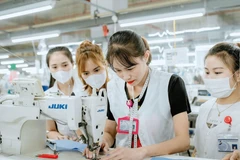Hanoi (VNA) – Export revenue in January was estimated at 29 billion USD, an increase of 1.6 percent compared to the same period last year, according to the Ministry of Industry and Trade (MoIT).
The ago-forestry-fishery sector brought in 2.67 billion USD, up 21.4 percent year-on-year and accounted for 9.2 percent of the total export turnover.
The export of industrial and processing products brought in 24.95 billion USD, up 0.2 percent over the same period, representing 86 percent of total export turnover.
“After the second year of the COVID-19 pandemic, production and business enterprises have gradually adapted to the situation, therefore, most export products in the first month of 2022 maintained positive growth," said a representative of the Ministry of Industry and Trade.
In January, seven commodities recorded export turnover of over 1 billion USD, accounting 63.3 percent of the country’s total. Telephones and components earned the largest export value of 4 billion USD, followed by computers, electronic products and components, textiles and apparel.
Than Duc Viet, General Director of Garment 10 Corporation, said that last year, despite the COVID-19 pandemic, the corporation still enjoyed growth in both revenue and profit. Its profit increased by 11 percent and the average income of employees increased by 7.6 percent compared to 2020.
It has received enough orders through to the second quarter of 2022, he said, adding that this is a favourable condition for the corporation to promote its creative and innovative capacity in doing its business.
Minister of Industry and Trade Nguyen Hong Dien emphasised that many Vietnamese goods have established an important position in the supply chain, such as phones and components; computers; textiles, footwear, furniture and aquatic products, adding that they are also the commodities that have had a good export growth in recent years.
“Vietnam has 15 Free Trade Agreements (FTAs) with key markets in the world, creating a great impetus for production and export activities, as well as helping us receive many advanced and modern technologies and trained a professional workforce,” Dien said.
Taking advantage of opportunities
Taking full advantage of free trade agreements (FTAs) seems to be one of the strengths of Vietnam's exports, especially when new-generation FTAs such as the Comprehensive and Progressive Agreement for Trans-Pacific Partnership (CPTPP), the EU-Vietnam Free Trade Agreement (EVFTA) and the UK-Vietnam Free Trade Agreement (UKVFTA) took effect.
The fact that the RCEP was effective from the beginning of this year was and will continue to be a new driving force for the country's exports.
Le Hang, Deputy Director of Vietnam Association of Seafood Exporters and Producers (VASEP) Training & Trade Promotion Centre (VASEP.PRO) said that in the last five years, the export turnover of processed seafood using imported materials accounted for 24-30 percent of the total turnover, significantly contributing to raising Vietnam to third in the world as terms of seafood exports.
“We see that the trade of seafood will soar rapidly as the industry is developing well thanks to modern processing technology, highly-skilled workers, and the advantage of FTAs,” said Hang.
Vietnam spent 29.5 billion USD on imports in January, up 11.5 percent year on year. The country incurred a trade deficit of 500 million USD, of which the domestic sector posted a trade deficit of nearly 2 billion USD while the foreign-invested sector, including crude oil, generated a trade surplus of 1.3 billion USD.
To create momentum for the implementation of socio-economic targets in the coming months, the MoIT has rolled out measures to support production and business, and promote exports. Attention has been paid to key projects at the beginning of the year to create a source of goods for production, domestic consumption and export.
The ministry has also made full use of opportunities brought about by FTAs to find solutions to develop markets and remove barriers to penetrate new markets.
Priority has been given to the implementation of export promotion activities and export markets that recovered well soon after the COVID-19 pandemic. The focus has been on closely monitoring the situation of each market to identify the types of goods that countries need for export promotion./.






























